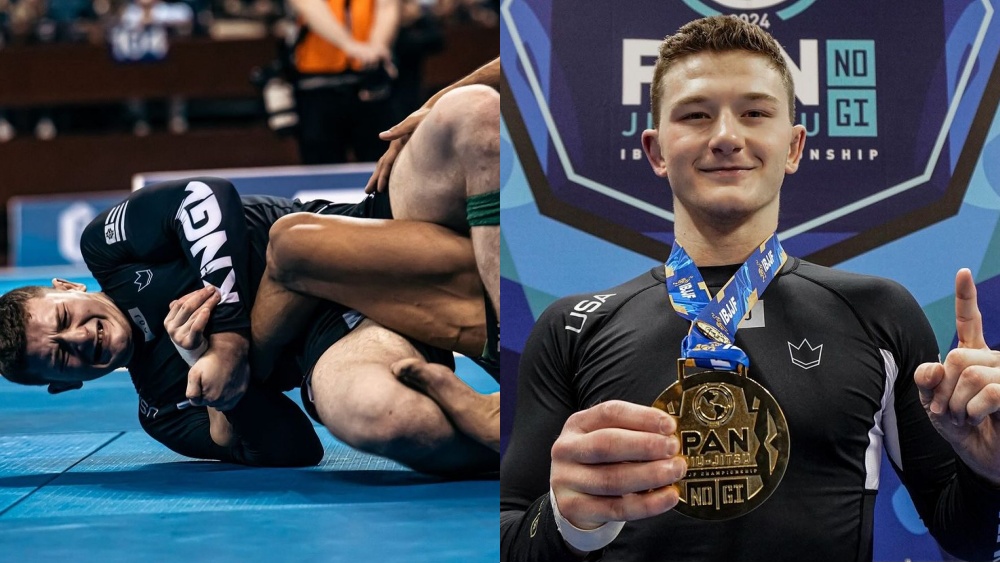Every BJJ student worldwide should aim to become proficient in using their favored techniques. The art of Brazilian Jiu-Jitsu is filled with many amazing techniques, and one person’s game can vary significantly from another, even if they train in the same academy. As such, it is not only essential to select techniques that will complement your game, but mastering how to use these techniques becomes equally critical. One of the most widely used submissions in BJJ is the kata gatame or arm triangle choke. It is a submission that has stood the test of time and is considered one of the most practical and versatile techniques in the art. Today, we will go over the kata gatame, discussing its underlying concepts, application, and strategic significance in Jiu-Jitsu.
What Is The Kata Gatame In BJJ?
The kata gatame, or arm triangle choke, is a powerful and versatile submission technique in grappling that targets the neck and throat of the opponent. Originating from Judo and also prevalent in other grappling martial arts, the kata gatame is both a control position and a choke that can be applied from various positions, including side control, top mount, and even guard in some scenarios.
To execute the kata gatame, the practitioner wraps one arm around the opponent’s neck, with the opponent’s arm trapped in between, creating a figure-four configuration by gripping their bicep or shoulder. The practitioner’s other hand is then placed behind the opponent’s head to secure the position. To finish the choke, the practitioner applies pressure by squeezing their elbows together and driving their shoulder into the opponent’s neck, cutting off blood flow through the carotid arteries, which can lead to submission due to lack of oxygen.
The effectiveness of the kata gatame lies in its ability to apply significant pressure with minimal risk to the practitioner. It’s a submission that relies more on technique and positioning than brute strength, embodying the principles of leverage that are fundamental to BJJ. Its versatility allows it to be a threat in various grappling situations, making it a valuable addition to any practitioner’s arsenal.
Steps To A Powerful Kata Gatame
While it is given that not all instructors teach the kata gatame the same way, it is safe to assume that their underlying concepts are more or less the same. Here are our top recommendations to ensure that your kata gatame is as good as it can be.
The first critical step is to establish a dominant control, usually using top pins like mount, kesa gatame, or side control. Doing this ensures that you have the ability to pin down the opponent, thus limiting their chances of escaping. The kata gatame is a submission that aims to control the head. Before controlling the head, you must also find ways to establish a dominant position. Once you establish the dominant position, it is now time to get the head and arm.
Your aim is to isolate one of your opponent’s arms and press it against their neck. You can do this by using your body and arms to manipulate their arm into position. In side control, for example, you might use your nearside arm to push the arm up while you use your head and shoulders to pin it in place. Wrap the arm that’s closest to your opponent’s head around their neck, sliding it underneath their isolated arm. Your bicep should be on one side of their neck, and your forearm on the other, essentially trapping their arm against their neck. Secure your grip by placing the hand of the arm that’s wrapping around the neck onto the bicep of your other arm.
Then, place your free hand on the back of your opponent’s head. This hand placement is crucial for tightening the choke. Once the grip is achieved, you can now secure the choke by tightening your grip against their head and arm. By using your arms and body position to compress the space against the opponent’s neck, you can undeniably increase the chances of finishing with the submission. Ensure that you position your body at an angle as you put pressure on the neck. Apply force in the direction of the opponent’s head and steadily put constant pressure to finish the submission.
A Great Addition To One’s Submission Game
Integrating the kata gatame into your overall game is a smart move that can significantly enhance your grappling game. This versatile submission offers a path to victory and serves as a formidable control technique, making it an essential tool for both Gi and No-Gi practitioners.
The kata gatame is primarily a submission you apply from the top position. You can use it in conjunction with your other techniques from the top position, specifically with moves like the gift wrap, technical mount, and kimura — all outstanding techniques that work well with the kata gatame.
Integrating the kata gatame into your game means more than just attempting the submission; it involves using the position as a pivot point in your strategy. Use the threat of the choke to set up other submissions or to improve your position. The possibility of the kata gatame forces your opponent to defend in specific ways, opening opportunities for transitions to the back or other dominant positions.
A Technique That Requires Patience
Patience is critical when applying the kata gatame. It’s a submission that often requires gradual pressure to secure, giving you time to adjust based on your opponent’s reactions. Be adaptable and willing to switch strategies if your initial attempt is defended. This might mean transitioning to a different submission or using your opponent’s defense against them to advance your position.
Conclusion
The kata gatame is one of the most widely used submissions for a reason. Adding it to your grappling repertoire not only improves submission options but also enhances overall mat control and strategic flexibility. Perfecting the kata gatame requires time to master, as is the case with all techniques in BJJ. Give it enough time, and we guarantee it will make you a better grappler!
You may also like:
6 Most Efficient Guards For Older Grapplers In Brazilian Jiu-Jitsu
















